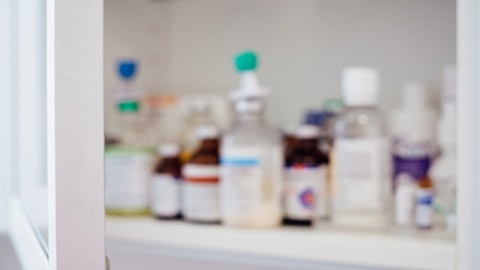The study is now open at MD Anderson, Vanderbilt, Duke and the University of Pennsylvania. The clinical trial is currently in the Phase 2 portion and overall is designed to enroll up to 60 patients. There are currently over 27 patients enrolled. The trial employs a stringent efficacy endpoint, deep response rate. Deep response rate is the CR rate plus the PR rate only counting PRs that achieve greater than 50% tumor volume reduction. Note the usual criteria for PRs is 30% tumor reduction. Data from the KCRC has shown that deep response rate correlates with long-term progression free survival and overall survival and in their previous studies is 32% with ipilimumab and nivolumab. In an interim analysis, our protocol defined pre-specified statistical threshold for efficacy is the demonstration of at least a 50% increase above the 32% deep response rate seen with previous ipi-nivo combination trials in renal cell cancer conducted by the Kidney Cancer Research Consortium.
This means we need to exceed a deep response rate of 48%. As of May 2, 2024, the interim analysis that was conducted indicates that we have met the statistical threshold for efficacy, so the trial continues to enroll patients. We are excited about these results given the positive clinical implications for patients. In addition, they are consistent with our laboratory and preclinical findings and we believe may represent a novel immunotherapy approach. Summarizing the outlook for the remainder of 2024 with our recent financing, our current cash gives us runway into late 2025, allowing us to achieve several near-term milestones, including starting our registrational Phase 3 clinical trial of soquelitinib and PTCL in the third quarter generating interim results from our soquelitinib Phase 1 atopic dermatitis trial before year end, followed by final data in early 2025, reporting additional data from the ciforadenant Phase 1b/2 clinical trial later this year and initiating a Phase 2 clinical trial with soquelitinib in solid tumors in the fourth quarter, with initial data anticipated in the second half of 2025.
We look forward to providing updates on our programs in the coming quarters. I will now turn the call over to the operator for a questions-and-answer period. Operator?
Q – Unidentified Analyst:
ralatrexate:
Richard Miller:
ralatrexate:
Unidentified Analyst: Okay, that’s helpful. And with the new responses, how much this is going to increase your sort of preliminary PFS and OS. I know you reported previously 6.2 months in PFS, 28 months in OS. So is it going to increase significantly?
Richard Miller: So the current ORR now, overall response rate is 39%. Just to remind you that. And by the way, in lymphoma we use the Lugano criteria, which is 50% for PR. And I should add that the PR that I just mentioned has about 87% reduction of tumor. One tumor was totally gone. I suspect he could be on his way to a CR very soon. The PFS, we expect the PFS to improve as these last few patients moved through the median.
Unidentified Analyst: Okay, understood. And regarding the data from the Phase 3 trial, when do you think we will have a first glimpse on the readout? I know this is randomized trial, blinded trial, but when do you think we’ll have the first look at it?
Richard Miller:
ralatrexate: There is an interim. There is a point that we conduct an interim analysis, which is when half of the events occur, the events being the PFS events, but that occurs so late in the study that we would probably wait for the end of the study to make a final determination. Now, having said that, we do have an outside data monitoring committee, and I guess if the results were so persuasive or compelling, you would possibly have an ethical reason to discontinue the study.
Unidentified Analyst: Okay, makes sense. And the last one, if I may.
Richard Miller: Let me just say, so I think you’ll have data from this trial in 24 months.
Unidentified Analyst: Okay. So, like 2026. Okay. So I’m trying to understand, these drugs seems to be working, and, but there is 40% who don’t respond essentially, 39% based on DCR. So is there any way to come up with some other potential biomarkers to screen patients who would be more likely to respond or somehow choose patients? Yeah.
Richard Miller: Well, we are working on that. We’re looking all the time for mutations and baseline immune status, et cetera. But you’ll remember that several months ago, we implemented, and on conference calls, I talked about the immune status at baseline, the absolute lymphocyte count, then using a number of prior therapies. I’m happy to report that since we’ve implemented those eligibility criteria, we have seen, I would say, not only more responses, but I would say the kinetics of the responses also have been faster. So I think that those moves that we made several months ago or maybe a year ago now, really have made a difference and those moves were based on our better understanding of the mechanism of action. So I expect that in a Phase 3 trial, we already know this, Phase 3 trial, we’re going to get better patients.
They’re going to have better immune status to start with. Phase 1 trials usually get sicker patients just by nature of the fact that they’ve exhausted any other therapies that are available. So I would expect that our results could get better. And we are continuing to look at different markers. But so far, I don’t know, other than the baseline immune status, I don’t know if we have a specific molecular marker.
Unidentified Analyst: Understood. Thank you. Thank you so much, and congratulations with the progress.
Operator: Your next question comes from the line of Jeff Jones from Oppenheimer. Your line is now open.
Jeff Jones: Thank you, operator and congrats on the news, guys. That’s great and congrats on the financing as well. One question on soquelitinib, there are a number of responders in the Phase 1 that were cutaneous T cell lymphoma patients. Can you remind me if cutaneous T cell lymphoma patients are going to be included in the Phase 3 and what impact that might have on the PFS?
Richard Miller: There are a couple of patients who are included in 23 that had cutaneous T cell lymphoma. Both of those patients had transformed cutaneous T cell lymphoma. That portends a very bad prognosis when you get what’s called large cell transformation. That’s not your typical CTCL is my point. CTCL patients are not going to be enrolled in our Phase 3 trial because it really is a different disease. It’s treated with different drugs and it can be a chronic disease early. In people who have just skin disease can have disease for many years. That’s not the patients we’re talking about in this trial. But Jeff, I think you raised a good point, which I forgot to mention. We see responses in cutaneous lymphomas, anaplastic lymphoma, peripheral T cell lymphomas, something called angioimmunoblastic, or now known as T follicular helper cell lymphoma.




